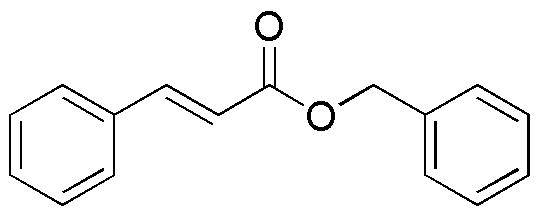Benzyl cinnamate is widely utilized in research focused on:
- Fragrance Industry: This compound is a key ingredient in perfumes and scented products, providing a sweet, floral aroma that enhances the overall scent profile.
- Cosmetics: Used in lotions and creams, it acts as a fragrance component and can also offer skin-conditioning benefits, making products more appealing to consumers.
- Food Industry: Employed as a flavoring agent, it adds a pleasant taste to various food products, particularly in confectionery and baked goods.
- Pharmaceuticals: Benzyl cinnamate has potential applications in drug formulation, where it can enhance the solubility and bioavailability of certain active ingredients.
- Research Applications: In scientific studies, it serves as a model compound for investigating esterification reactions and the development of new synthetic methodologies.
General Information
Properties
Safety and Regulations
Applications
Benzyl cinnamate is widely utilized in research focused on:
- Fragrance Industry: This compound is a key ingredient in perfumes and scented products, providing a sweet, floral aroma that enhances the overall scent profile.
- Cosmetics: Used in lotions and creams, it acts as a fragrance component and can also offer skin-conditioning benefits, making products more appealing to consumers.
- Food Industry: Employed as a flavoring agent, it adds a pleasant taste to various food products, particularly in confectionery and baked goods.
- Pharmaceuticals: Benzyl cinnamate has potential applications in drug formulation, where it can enhance the solubility and bioavailability of certain active ingredients.
- Research Applications: In scientific studies, it serves as a model compound for investigating esterification reactions and the development of new synthetic methodologies.
Documents
Safety Data Sheets (SDS)
The SDS provides comprehensive safety information on handling, storage, and disposal of the product.
Product Specification (PS)
The PS provides a comprehensive breakdown of the product’s properties, including chemical composition, physical state, purity, and storage requirements. It also details acceptable quality ranges and the product's intended applications.
Certificates of Analysis (COA)
Search for Certificates of Analysis (COA) by entering the products Lot Number. Lot and Batch Numbers can be found on a product’s label following the words ‘Lot’ or ‘Batch’.
*Catalog Number
*Lot Number
Certificates Of Origin (COO)
This COO confirms the country where the product was manufactured, and also details the materials and components used in it and whether it is derived from natural, synthetic, or other specific sources. This certificate may be required for customs, trade, and regulatory compliance.
*Catalog Number
*Lot Number
Safety Data Sheets (SDS)
The SDS provides comprehensive safety information on handling, storage, and disposal of the product.
DownloadProduct Specification (PS)
The PS provides a comprehensive breakdown of the product’s properties, including chemical composition, physical state, purity, and storage requirements. It also details acceptable quality ranges and the product's intended applications.
DownloadCertificates of Analysis (COA)
Search for Certificates of Analysis (COA) by entering the products Lot Number. Lot and Batch Numbers can be found on a product’s label following the words ‘Lot’ or ‘Batch’.
*Catalog Number
*Lot Number
Certificates Of Origin (COO)
This COO confirms the country where the product was manufactured, and also details the materials and components used in it and whether it is derived from natural, synthetic, or other specific sources. This certificate may be required for customs, trade, and regulatory compliance.

